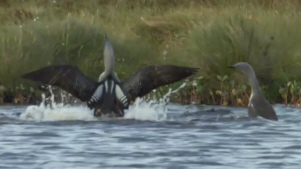The Machair - Isle of Lewis
Red-Throated Diver - Black-Throated Diver
Hebrides: Islands on the Edge - Ewan McGregor
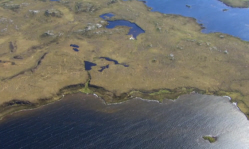
There’s a good reason that nesting birds cling to the islands’ edges. The interior of Lewis is vast, but it’s not fertile like the surrounding seas. Lashed by strong westerlies, the rocks are covered by layers of peat and studded with small lochs.
Fish don’t thrive in these isolated pools and that’s good for damselflies. Their vulnerable young live underwater. But first they have to get there - and that means laying eggs.
On one of the first really warm days of summer, a male damselfly has found a mate and the pair lock together. She needs his help to break through the surface, so he’s pushing her under. But he’s slipped.
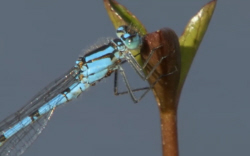
And then, disaster!
A gust of wind breaks them apart. He can’t help her now but she presses on alone. Underwater, she must split open the stem and lay her eggs. But getting out again without the male’s help is going to be very tricky.
On the other side of the pool, one of Britain’s rarest birds sits on recently laid eggs - a red-throated diver! This pair’s first nest was washed away by the storms. This is their only chance to raise young this year. The watery world of the Western Isles is vital to the red-throated divers. Their legs are so well adapted for swimming that they can’t walk properly, so they can only nest right on the edges of pools like this. And that makes changeovers a clumsy affair, more like falling in and out of bed.
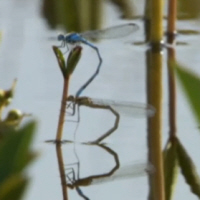
While the female takes her turn on the eggs, the male heads out to sea in search of fish. But while he’s away, the female is exposed to danger. It’s a black-throated diver - bigger, more powerful, and looking for a new home.
At the edge of the lochan, a damselfly is in distress. The female damselfly can’t break free of the water’s surface without the male to help her. But then she manages to flip a wing up - and another! And like tiny sails, they catch the breeze. Predatory dragonfly larvae are close by. They’ll kill her if they notice she’s there. She’s drifted against a stem. This gives her some leverage out of the water, and, at last, a safe place to dry out. But she still has more eggs to lay, so tomorrow she’ll go through it all over again.
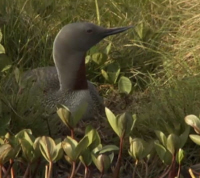
The male red-throated diver arrives back and discovers the black-throat on his lochan. The smaller diver starts to panic but it must defend the female on the nest. For all their ungainliness above water, these birds are like torpedoes underneath. Their bills are like knives - a stab from below could be lethal. The commotion draws the female red-throated diver off the nest to help her mate. But the black-throated diver is heading straight towards her.
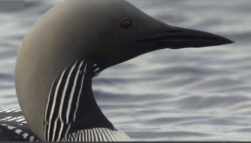
And suddenly they’re on top of one another. The black-throated diver is taken completely by surprise… And the female red-throat seizes the chance to lure the intruder away. It’s all too much. Rattled, the black-throat makes a hasty exit. It’s back on the eggs as quickly as possible. If they’re left too long, they’ll chill and won’t hatch.
The Machair
It’s early July. With 18 hours of daylight, conditions are perfect for growing crops. But, even now, farming in the Outer Hebrides is never easy. The islands of Uist and Benbecula appeared the most unforgiving. Scraped by long-gone glaciers, they are now as much water as land. But running down the Atlantic side of the islands is one of the jewels of the Hebrides… the machair.
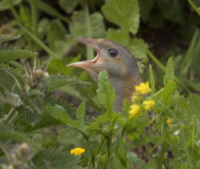
Lying between the unfertile moorland and the sea, it’s like a Scottish Garden of Eden. Over centuries, the winds have blown shell-sand up onto the islands, balancing out the acid of the peat. But the machair wouldn’t be this rich if it wasn’t for people. Generations of crofters have carried seaweed onto the land to make it more fertile, and they leave the small fields fallow in some years - allowing wildflowers, insects and birds to move in. In high summer, the machair hums with rare bees like the moss carder and the great yellow bumblebee - extinct in most of mainland Britain. Meadows like this hardly exist there anymore because of intensive farming.
There are always corners for the corncrake - whose surreal rasping call is heard almost nowhere else in Britain. It’s flourishing here in the Uists.
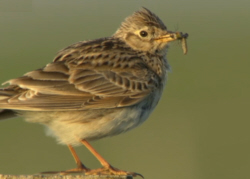
The rich supply of insects makes this an ideal home for skylarks. Their nest is well hidden amongst the flowers. The chicks are brilliantly camouflaged with tendril-like feathers on their heads helping them blend in with the grass.
The machair is also globally important because it’s home for birds like lapwings which nest on the ground. In a normal year, they will have finished raising their chicks by now, but they were also hit by the storms. So along with other local residents like redshanks and oystercatchers, they’re sharing the machair with recently arrived migrants.
It’s much more crowded than usual and the lapwings are kept busy defending their patch. Wader chicks hatch fully fluffed-up and ready to go. It’s like keeping control of half a dozen wayward toddlers all at once.
The mother Lapwing has a real job on her hands to keep her brood together - and safe.
